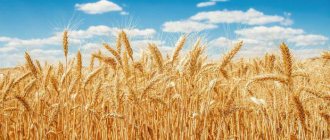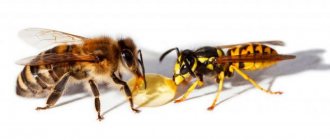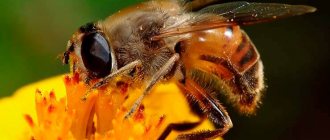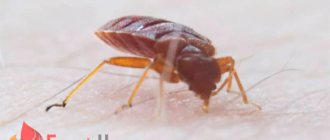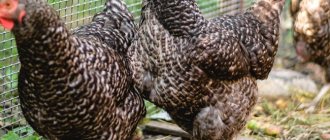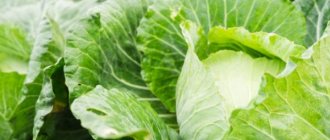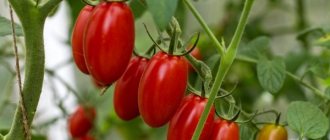Similarities of cereals
Wheat, rye, barley and oats are all human-cultivated grains. Plants have a similar structure:
- tall, hollow stem;
- inflorescence in the form of a spike (in oats it is collected in a panicle of ears);
- leaves are narrow and long;
- grain fruit;
- The outer shell of the grain is hard, the inner is soft.
All these crops are divided into two types according to the method of cultivation: spring and winter.
Any of the plants can be used as green manure to restore the structure and nutritional value of the soil. The following grains are used as food:
- The grains are ground into flour to make bread or flatbreads and other baked goods.
- The cereal is used as a side dish or first course.
- After processing, the grains are used to prepare cereals for quick breakfasts.
- Cereals are the raw material for making alcohol (alcohol production).
- The grains are used to make malt to make beer.
Plant straw was used in ancient times as a building material. Now, the so-called silage is used to feed farm animals, and straw serves as bedding. Crushed grain is fed to poultry.
What is rye - what do the spikelets look like, what are the inflorescences called?
Rye
Rye is also a cereal, and it has up to 13 species, of which only one is cultivated.
The stem is erect, hollow, has nodes and grows up to one meter. In rare cases it can reach two. The leaves have a bluish color and have fibers. The ears are arranged in two rows and grow up to 15 cm. In addition, rye is not very picky about the soil and can grow even on sandy terrain.
As for the chemical composition, it includes proteins and carbohydrates, as well as vitamins and important microelements. Rye flour is used for baking bread. Rye bran is an excellent source of fiber and is actively used by those losing weight.
The main differences between barley, wheat, rye and oats
Despite the great similarity, the plants are still different. The cultivation technique for cereal plants is almost identical, with the exception of minor subtleties. But growing conditions for each crop are selected individually.
To compare external and biological features, a table is presented:
| Plant | External differences | Difference in growing conditions |
| Oats | The inflorescence is complex - a panicle collected from drooping single ears. The grain is elongated, gray-yellow | Tolerates frost down to -9°C, but does not like heat. Moisture-loving, not resistant to drought. It is not demanding on the structure and composition of the soil, provided the acidity is 5-6 pH |
| Rye | Single inflorescence spike, flat. The grains are pressed to the stem, opposite. Elongated oval shape, gray-yellow, brownish color | Tolerates frosts down to -20°C, is drought-resistant, does not like waterlogging. Soil composition does not matter, except in wetlands, adapts to high acidity |
| Wheat | The grains on a mature ear sit alternately, more convex. The color is golden yellow, the shape is oval-round. | Heat- and moisture-loving soils are loamy or sandy loam, flavored with humus or fertile chernozem. Soil acidity 5.5-6 pH |
| Barley | The ear is short, the grains are arranged alternately, convex. Round-oval shape with a sharp yellow-gray end | Withstands frosts down to -12°C, heat up to +33°C. Drought-resistant, can grow in poor soils, but neutral or slightly acidic acidity is desirable |
Did you know? British scientists from Cardiff University, after conducting experiments, came to the conclusion that oatmeal improves brain function. A daily serving of porridge stimulates thinking, memory and concentration.
Description of the species
Barley is a grain crop that can grow both wild and cultivated for food purposes. This cereal belongs to the genus Hordeum and has more than 40 varieties. The crop is classified according to the number of fruiting spikelets, its density, and the filminess of the grain, among which are the following types:
- The very first cultivated species, wild two-row barley (Hordeum distichon), was discovered during excavations in Ancient Asia about 7 thousand years BC. On the ledge of the rod there are two sterile lateral spikelets and the middle one is fertile. The representative of the species has two subspecies: with spikelet lateral scales and with flowering ones.
- During the birth of agriculture in Ancient Egypt and Mesopotamia 2 millennia ago, multi-row barley (Hordeum vulgare) began to be cultivated. All three spikelets located on the stem segment are fertile. Depending on the density of the spikelet, this type has the following subspecies: six-rowed with a regular shape, resembling a dense and at the same time short hexagon, and irregular six-rowed, in which the spikelets located on the sides overlap each other, forming a quadrangle. Multi-row barley is a plant popular in our latitudes; it ripens quickly and is resistant to arid climates and is not picky about the choice of soil.
Currently, agricultural producers prefer two-row or ordinary barley, whose origins go back to Central Asia.
Chemical composition and nutritional value
The composition of useful substances in cereals is similar to each other, as is BJU.
All crops are rich in minerals and vitamins, especially group B elements:
- vitamins - B1, B2, B4, B5, B6, B9, E, H, PP;
- macroelements - potassium, calcium, silicon, magnesium, sulfur, phosphorus;
- microelements - iron, cobalt, manganese, copper, selenium, molybdenum, chromium, zinc.
The table below shows the energy value of plant grains:
| Rye |
|
| Wheat |
|
| Oats |
|
| Barley |
|
Did you know? Barley is mentioned in many religious texts: the Bible, the Torah, and also the Hindu Rig Veda.
Growing a cereal garden
Some gardeners dream of growing not only traditional fruits and vegetables, but also grains on their plots. This idea has a high practical meaning; growing grain in a garden plot helps to provide yourself with the necessary grains or make flour yourself. A small plot, of course, will not allow you to feed a whole family throughout the year, however, a grain harvest can partially solve the problem of purchasing goods in a store. As an added bonus, winter wheat acts as a cover crop, meaning your garden will be protected from weed growth.
Benefits for the body
Nutritionists recommend including porridge in your diet at least 3 times a week. A dish made from grains contains fiber, which “sweeps” undigested food, drug breakdown products and toxins from the body. This fact has a positive effect on the digestive process and allows you to maintain normal weight. Each cereal has other qualities that are valuable for the human body.
- Useful properties of wheat:
- relieves inflammation and pain from rheumatism;
- normalizes blood sugar levels;
- promotes insulin production;
- supports the functioning of the heart muscle;
- normalizes cholesterol levels;
- improves the functioning of the nervous system;
- reduces the risk of Alzheimer's disease;
- normalizes the functioning of the reproductive organs;
- reduces the risk of developing cataracts;
- is a prevention of bronchial asthma;
- normalizes intestinal microflora;
- supports healthy skin and hair.
Wheat grains have long been used in the preparation of medicines for diseases of the gastrointestinal tract, genitourinary system and skin. It is useful to eat whole grain porridge if you suspect kidney stones or gall bladder.
Also learn about the effects of puffed wheat on human health.
- Benefits of rye for the body:
- improves hematopoietic function;
- normalizes the functioning of the lymphatic system;
- improves digestion processes;
- supports the functioning of the central nervous system;
- improves adrenal function;
- helps in the treatment of skin diseases;
- has a positive effect on the condition of the oral cavity;
- strengthens muscle and bone tissue;
- improves the transmission of nerve impulses.
In folk medicine, grain decoctions are used both internally and externally. Biologically valuable, given the composition of the plant, is kvass. Sprouted rye sprouts promote weight loss, help restore vision and saturate the body with vitamins and minerals in full.
Important! Before using homeopathic remedies, it is recommended to consult with your doctor. This is especially true for people with chronic diseases of internal organs.
- Beneficial properties of barley:
- fights viruses and fungi;
- has an astringent and expectorant effect;
- reduces the risk of heart disease;
- strengthens cartilage and bone tissue;
- promotes lactation in nursing mothers;
- maintains the balance of vitamins and minerals in pregnant women;
- accelerates cell regeneration processes;
- reduces the acidity of gastric juice.
Barley contains less dietary fiber and starch than wheat and rye. Therefore, nutritionists recommend that diabetics and obese patients consume the products. Barley grains are used in folk medicine and cosmetology.
- Benefits of oats:
- helps fight obesity;
- improves the condition of skin and hair, strengthens nails;
- reduces blood glucose levels;
- supports the female body during menopause;
- increases the elasticity of blood vessels;
- normalizes blood pressure;
- strengthens the immune system;
- improves the functioning of the reproductive organs;
- eliminates insomnia and anxiety.
Extraordinary barley
The culture of growing barley dates back approximately 10 thousand years. Valuable grain has long been used for baking, cooking, making malt, beer, and animal feed. Barley production is still of great importance today.
Many people are happy to include highly nutritious barley porridges in their diet: pearl barley - from polished whole grains, barley - from crushed, instant - from processed flattened grains.
Barley flour contains little gluten, so it is not used in its pure form for baking. By combining with wheat flour, you can prepare products that are original in taste and healthy: bread, pancakes, cookies, pies.
Feed enriched with a very small amount of barley increases the gain of meat and fat in animals by 30-40%. This indicates a high content of easily digestible protein in the cereal.
A healthy coffee substitute is prepared from roasted and ground barley grains. It does not contain caffeine, which is contraindicated in some diseases, and a lot of useful elements will have a health-promoting effect.
Brewing is an ancient and traditional activity for many peoples, and it is unthinkable without malt. It is obtained from sprouted, dried and crushed barley grains.
Possible harm and contraindications
The harmful properties of cereals are almost the same. Cereal dishes should not be consumed in large quantities, as this will lead to weight gain.
- In addition, it will provoke unpleasant side effects:
- bloating;
- heartburn;
- increased acidity;
- feeling of heaviness;
- constipation.
Important! Patients with celiac disease should strictly not consume foods containing grains in large quantities. All of the above crops contain gluten.
You need to be careful when handling sprouted grains . They are certainly useful, since the content of valuable elements in the composition is maximum. But you need to buy a product for germination at a pharmacy; grain at the market and at food outlets can be treated with pesticides. You should inquire about the conditions for germination and storage of such a product.
Thus, you can distinguish the crop both by looking at the bush and by the appearance of the grain. The main thing that unites cultures is the benefit they bring to the body.
What is wheat - what do the spikelets look like, what are the inflorescences called: characteristics
Wheat
Wheat is a cereal and is considered the most important domestic crop. Today's wheat comes in many varieties, but all stems are similar in different ways. Its stems are hollow, straight and with nodes. One root can grow up to 12 stems at once. They can reach 1.5 meters in height. Their leaves are flat, fibrous and rough.
The leaves are very long and quite thin - no more than 2 cm. Hairs may grow on some, but there may not be any. Fibrous root system, inflorescences up to 15 cm. Each ear has 3-5 spikelets with two scales.
The fruit of wheat is the grain. Each grain contains many useful substances, such as gluten, carbohydrates and other microelements.
Wheat flour is mostly used to create bread and pasta. The grains are ideal for cereals and also for producing alcohol. Wheat bran helps cope with high blood sugar and cholesterol levels. But that's not all. Wheat is ideal for making feed, various preparations and even rejuvenating extract.
Growing winter and spring rye: sowing, fertilizers, care
To grow rye as a crop, an elevated, open area is chosen; maximum lighting is necessary for the grains to fully ripen.
For winter and spring rye, it is necessary to apply organic fertilizers (manure, compost) and mineral fertilizers (nitrogen, phosphorus, potassium).
Winter rye is sown a month and a half before the onset of persistent cold weather. To do this, sorted seeds with high levels of purity and germination are selected and treated to avoid the occurrence of diseases. Seeds are planted in pre-designated rows 15 cm apart to a depth of 5-7 cm.
Sowing of spring rye is carried out in the spring, at the earliest possible time, in dug up and fertilized soil. Seeds germinate at low temperatures above zero, and seedlings are not afraid of frost.
Interesting facts about rye
- A familiar and simple cereal, however, can be considered a rather interesting plant. At the end of the last century, Luxembourg occupied a leading position in the world in the incidence of bowel cancer. After adding diseased bran and rye bread to the diet, the city quickly found itself at the end of this terrible list.
- In Rus', ears of rye tied into a bundle drove away evil forces from newborns and protected them from the “black eye” by placing oven-dried cereal under a mattress in a cradle.
- Rye flour is an excellent remedy for boils and abscesses: a cake of it is applied to the sore spot, and within a day or two relief comes.
Did you like the article? Share with your friends:
Buckwheat
Buckwheat (esculentum moenh) is a herbaceous plant up to 190 cm high. It is an annual plant. It is divided into subspecies - ordinary (vulgare) and multi-leaved (multifolium).
The hollow ribbed stem branches. The leaves are arrow-shaped and arranged alternately. The flowers are collected in clusters and have an intense aroma, which attracts honey insects.
Buckwheat has good nutritional properties, a pleasant taste and is easy to digest. The protein in buckwheat fruits contains a large number of valuable amino acids, so it is considered one of the best dietary foods.
Buckwheat, kernels and flour are used for food consumption. Waste from processing is used to feed livestock.
The yield of buckwheat depends on where it grows. The greatest yield is produced by crops located close to forest belts.
